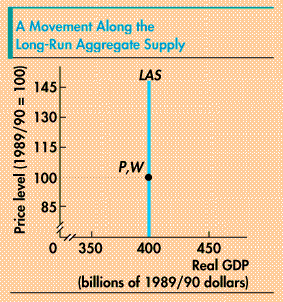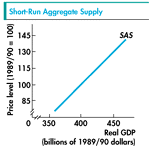Chapter 22
The key question is why doesn't GDP change when the economy moves along its LAS curve? The figure indicates the answer: When moving along the LAS curve, the price level rises (as shown by the growing size of the P next to the moving arrow) and so does the money wage rate (as shown by the growing size of the W next to the arrow). The basic economic idea is that as the price level rises, the wage rate responds so that at the new long-run equilibrium the wage rate has had enough time to have risen by the same percentage as the price level. Hence firms find that the prices they receive for their goods and services have increased but so has the wage rate that they pay their workers. With prices and costs up the same percentage, firms can make no extra profit from increasing production of goods and services. So firms do not change the amount of their output. The defining characteristic of the LAS
curve is that:
|
 The vertical slope of the long-run
aggregate supply curve (LAS) means that as the
price level rises and the economy moves along its LAS
curve, real GDP does not change. The arrow moving in
the figure shows this result. As the price level
increases from 100 to 130, real GDP remains constant
at $400 billion.
The vertical slope of the long-run
aggregate supply curve (LAS) means that as the
price level rises and the economy moves along its LAS
curve, real GDP does not change. The arrow moving in
the figure shows this result. As the price level
increases from 100 to 130, real GDP remains constant
at $400 billion. 